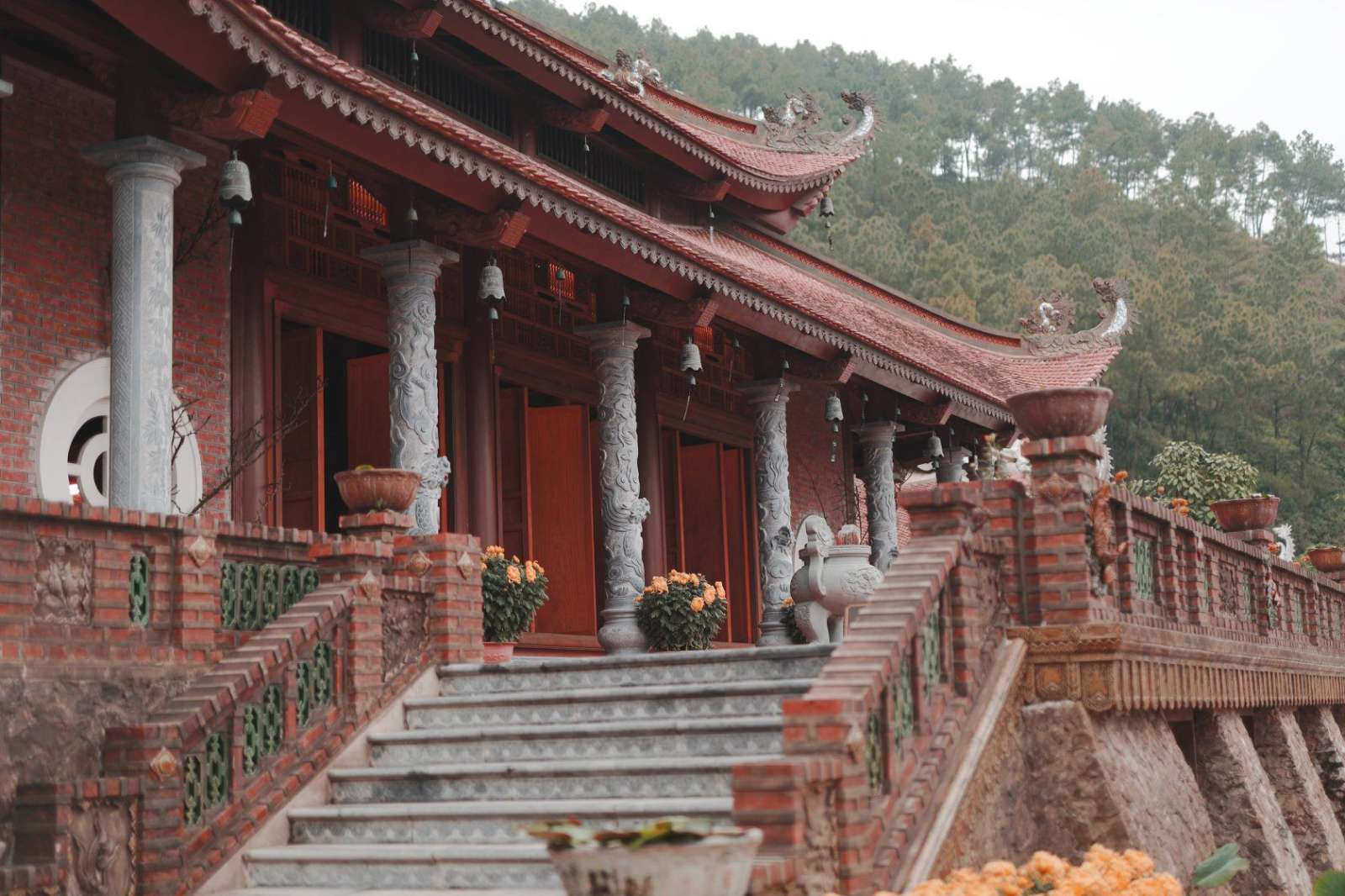Tien Ong Temple - A Spiritual Historical Site in Ha Nam
Ha Nam, a province located in the Northern Delta region of Vietnam, is a land adorned with the untouched grandeur of nature and rich historical heritage, deeply rooted in cultural traditions. Among the list of tourist attractions in Ha Nam, Tien Ong Temple stands as a captivating destination, alluring visitors not only with its ancient architectural beauty but also with its profound spiritual significance.
Geographical Location

Tien Ong Temple is situated in Tuong Linh Commune, Kim Bang District, Ha Nam Province. The temple was built during the reign of King Tran Nhan Tong on the slopes of Tuong Linh Mountain, at an elevation of about 200 meters. The temple is part of the Bat Canh Son historical complex, a group of structures constructed according to the legend of the Eight Diagrams and Five Elements.
Architectural Features of Tien Ong Temple


During his lifetime, Tien Ong contributed greatly to the local community, providing healing and assistance to those in need. After attaining enlightenment, he transformed into a "Dai Nai" tree and instructed people to carve statues for worship from the tree's wood and cast bronze statues for worship. The statues were known to exhibit miraculous properties.
Throughout history, despite wars and destruction, the statues were often moved but remained invulnerable. Even when Nguyen Huu Chinh attempted to melt down the bronze statue for currency, the statue could not be damaged. Witnessing this, Nguyen Huu Chinh prayed that if the statue was truly sacred, the Chau River should flow during both rain and drought. Miraculously, his prayer was answered. Subsequently, Nguyen Huu Chinh ordered his soldiers to return the statue to the temple.
Many kings and lords, such as Le Thai To, Le Du Tong, Trinh Doanh, Trinh Tung, Trinh Sam, and Mac Phuc Hai, visited the temple. According to local folklore, Le Quy Don and Nguyen Huy Oanh are said to be descendants of Tien Ong.
With its ancient and sacred aura, Tien Ong Temple has become a renowned spiritual destination in Ha Nam. When visiting this land, come to Tien Ong Temple to experience the deep spiritual values that have been preserved for centuries, offering a glimpse into the historical breath of bygone eras, from the earliest days of antiquity.
Geographical Location

Tien Ong Temple is situated in Tuong Linh Commune, Kim Bang District, Ha Nam Province. The temple was built during the reign of King Tran Nhan Tong on the slopes of Tuong Linh Mountain, at an elevation of about 200 meters. The temple is part of the Bat Canh Son historical complex, a group of structures constructed according to the legend of the Eight Diagrams and Five Elements.
Architectural Features of Tien Ong Temple

Tien Ong Temple has undergone several renovations to achieve its grand scale today. The front gate of the temple is constructed in the stacked-layer style with eight curved roofs, featuring four dragon-head corners that are elegantly crafted, and the tiled roofs are symmetrically designed. The central hall of the temple is built with three arched doors in traditional Vietnamese style, while the rear hall features an arched vault. This architectural design not only imparts a sense of grandeur and reverence but also showcases the uniqueness and sophistication of the structure.
A notable feature of the temple is the pair of statues enshrined in the rear hall, one made of wood and the other made of bronze. The presence of these statues attracts the attention of both tourists and devotees who come to visit Tien Ong Temple.
With its distinctive architecture and valuable artifacts, Tien Ong Temple is not only an important spiritual site but also a historical and cultural treasure worth exploring in Ha Nam. The combination of art and spirituality creates a sacred and profound space, offering a meaningful experience for every visitor.
The Legend of Tien Ong Temple
Tien Ong Temple venerates Nam Thien Dai Thanh, also known as the Divine Founder of the Dharma, a Bodhisattva. According to legend, Tien Ong's father was a prominent official under the Tran Dynasty who had 23 concubines but no sons. It wasn't until he moved to Son Nam Town, Thinh Dai (now Dai Cuong Commune) in Kim Bang District, that his 24th concubine bore him a son, Tien Ong.
Tien Ong had a unique appearance since birth. Throughout his life, he devoted himself to Buddhism and traveled extensively to seek spiritual teachings. When passing through Quang Thua area (now Tuong Linh Commune), he was captivated by the majestic Bat Canh Son range. He established a temple at the foot of Tam Giao Cave to worship the Buddha, ancestors, and parents, naming it Tam Giao Temple.
A notable feature of the temple is the pair of statues enshrined in the rear hall, one made of wood and the other made of bronze. The presence of these statues attracts the attention of both tourists and devotees who come to visit Tien Ong Temple.
With its distinctive architecture and valuable artifacts, Tien Ong Temple is not only an important spiritual site but also a historical and cultural treasure worth exploring in Ha Nam. The combination of art and spirituality creates a sacred and profound space, offering a meaningful experience for every visitor.
The Legend of Tien Ong Temple
Tien Ong Temple venerates Nam Thien Dai Thanh, also known as the Divine Founder of the Dharma, a Bodhisattva. According to legend, Tien Ong's father was a prominent official under the Tran Dynasty who had 23 concubines but no sons. It wasn't until he moved to Son Nam Town, Thinh Dai (now Dai Cuong Commune) in Kim Bang District, that his 24th concubine bore him a son, Tien Ong.
Tien Ong had a unique appearance since birth. Throughout his life, he devoted himself to Buddhism and traveled extensively to seek spiritual teachings. When passing through Quang Thua area (now Tuong Linh Commune), he was captivated by the majestic Bat Canh Son range. He established a temple at the foot of Tam Giao Cave to worship the Buddha, ancestors, and parents, naming it Tam Giao Temple.

During his lifetime, Tien Ong contributed greatly to the local community, providing healing and assistance to those in need. After attaining enlightenment, he transformed into a "Dai Nai" tree and instructed people to carve statues for worship from the tree's wood and cast bronze statues for worship. The statues were known to exhibit miraculous properties.
Throughout history, despite wars and destruction, the statues were often moved but remained invulnerable. Even when Nguyen Huu Chinh attempted to melt down the bronze statue for currency, the statue could not be damaged. Witnessing this, Nguyen Huu Chinh prayed that if the statue was truly sacred, the Chau River should flow during both rain and drought. Miraculously, his prayer was answered. Subsequently, Nguyen Huu Chinh ordered his soldiers to return the statue to the temple.
Many kings and lords, such as Le Thai To, Le Du Tong, Trinh Doanh, Trinh Tung, Trinh Sam, and Mac Phuc Hai, visited the temple. According to local folklore, Le Quy Don and Nguyen Huy Oanh are said to be descendants of Tien Ong.
With its ancient and sacred aura, Tien Ong Temple has become a renowned spiritual destination in Ha Nam. When visiting this land, come to Tien Ong Temple to experience the deep spiritual values that have been preserved for centuries, offering a glimpse into the historical breath of bygone eras, from the earliest days of antiquity.

.jpg)








